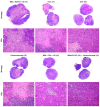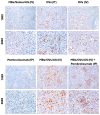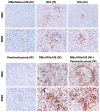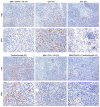Microbubble-Protected Oncolytic Virotherapy Targeted by Sonoporation Induces Tumor Necrosis and T-Lymphocyte Infiltration in Humanized Mice Bearing Triple-Negative Breast Cancer
- PMID: 39769460
- PMCID: PMC11678396
- DOI: 10.3390/ijms252413697
Microbubble-Protected Oncolytic Virotherapy Targeted by Sonoporation Induces Tumor Necrosis and T-Lymphocyte Infiltration in Humanized Mice Bearing Triple-Negative Breast Cancer
Abstract
Oncolytic virotherapy has shown great promise in mediating targeted tumor destruction through tumor-selective replication and induction of anti-tumor immunity; however, obstacles remain for virus candidates to reach the clinic. These include avoiding neutralizing antibodies, preventing stimulation of the adaptive immune response during intravenous administration, and inducing sufficient apoptosis and immune activation so that the body's defense can work to eradicate systemic disease. We have developed a co-formulation of oncolytic viruses (OVs) with Imagent® lipid-encapsulated, perfluorocarbon microbubbles (MBs) to protect the OVs from the innate and adaptive immune system. Once inside the MB, the viral particles become acoustically active such that external ultrasound can target the delivery of the virus locally within the tumor. Humanized NSG female mice (Hu-CD34+ NSG-SGM3) engrafted in their flanks with MDA-MB-231-Luc triple-negative breast cancer (TNBC) cells were transduced with MB/OVs, with or without adjuvant Pembrolizumab treatment, and tumor sizes and tumor necrosis were assessed. The presence of CD8+ (cytotoxic T-cells), CD4+ (helper T-cells), and CD25+ (Tregs) tumor-infiltrating lymphocytes (TILs) was quantified in the tumor samples by immunohistochemistry. In an in vivo model of humanized mice engrafted with a human immune system, we observed significantly greater tumor necrosis and smaller tumor mass in human TNBC xenografts systemically treated with MB/OV complexes in the presence or absence of pembrolizumab adjuvant treatment, compared to controls. Additionally, we observed a low ratio of CD4+/CD8+ TILs and a high ratio of CD8+/CD25+ TILs in the MDA-MB-231 xenografts treated with MB/OVs complexes with or without pembrolizumab adjuvant treatment, compared to controls. Our study demonstrated the feasibility of using MBs to target OVs to TNBC through diagnostic ultrasound, which decreased tumor mass by increasing tumor necrosis and stimulated a local and systemic antitumoral immune response by increasing intratumoral CD8+ T-cytotoxic lymphocyte infiltration and decreasing CD25+ Treg cells.
Keywords: cavitation; gene therapy; immunotherapy; microbubbles; microspheres; oncolytic virus; ultrasound; ultrasound contrast agent.
Conflict of interest statement
Authors C.T.L., E.G.S., and R.L. were employed by the company Vesselon, Inc. The remaining authors (J.S., F.D.C., I.K., J.H.T., P.P., G.C.D., M.B., L.D.V., C.M.H., and P.P.C.) declare that the research was conducted in the absence of any commercial or financial relationships that could be construed as a potential conflict of interest.
Figures







Similar articles
-
Oncolytic reovirus enhances the effect of CEA immunotherapy when combined with PD1-PDL1 inhibitor in a colorectal cancer model.Immunotherapy. 2025 Apr;17(6):425-435. doi: 10.1080/1750743X.2025.2501926. Epub 2025 May 12. Immunotherapy. 2025. PMID: 40353308
-
Treatment with oncolytic vaccinia virus infects tumor-infiltrating regulatory and exhausted T cells.J Immunother Cancer. 2024 Aug 17;12(8):e009062. doi: 10.1136/jitc-2024-009062. J Immunother Cancer. 2024. PMID: 39153823 Free PMC article.
-
Ultrasound-targeted microbubble destruction improved the antiangiogenic effect of Endostar in triple-negative breast carcinoma xenografts.J Cancer Res Clin Oncol. 2019 May;145(5):1191-1200. doi: 10.1007/s00432-019-02866-7. Epub 2019 Feb 25. J Cancer Res Clin Oncol. 2019. PMID: 30805775 Free PMC article.
-
Oncolytic immunovirotherapy: finding the tumor antigen needle in the antiviral haystack.Immunotherapy. 2025 Jun;17(8):585-594. doi: 10.1080/1750743X.2025.2513853. Epub 2025 Jun 6. Immunotherapy. 2025. PMID: 40474818 Review.
-
Oncolytic virotherapy and tumor microenvironment modulation.Clin Exp Med. 2025 Jul 20;25(1):256. doi: 10.1007/s10238-025-01691-2. Clin Exp Med. 2025. PMID: 40685482 Free PMC article. Review.
Cited by
-
Oncolytic viruses: a promising therapy for malignant pleural effusion and solid tumors.Front Immunol. 2025 Apr 25;16:1570698. doi: 10.3389/fimmu.2025.1570698. eCollection 2025. Front Immunol. 2025. PMID: 40352942 Free PMC article. Review.
-
Oncolytic Virus Infection Modulates Lysine Acetyltransferase in Gliomas: Comprehensive Analysis and Experimental Validation of KAT8 in Glioma.J Cell Mol Med. 2025 Apr;29(8):e70558. doi: 10.1111/jcmm.70558. J Cell Mol Med. 2025. PMID: 40259204 Free PMC article.
References
-
- Carlisle R., Choi J., Bazan-Peregrino M., Laga R., Subr V., Kostka L., Ulbrich K., Coussios C.C., Seymour L.W. Enhanced tumor uptake and penetration of virotherapy using polymer stealthing and focused ultrasound. J. Natl. Cancer Inst. 2013;105:1701–1710. doi: 10.1093/jnci/djt305. - DOI - PMC - PubMed
-
- Greco A., Di Benedetto A., Howard C.M., Kelly S., Nande R., Dementieva Y., Miranda M., Brunetti A., Salvatore M., Claudio L., et al. Eradication of therapy-resistant human prostate tumors using an ultrasound-guided site-specific cancer terminator virus delivery approach. Mol. Ther. 2010;18:295–306. doi: 10.1038/mt.2009.252. - DOI - PMC - PubMed
MeSH terms
Grants and funding
LinkOut - more resources
Full Text Sources
Research Materials
Miscellaneous

